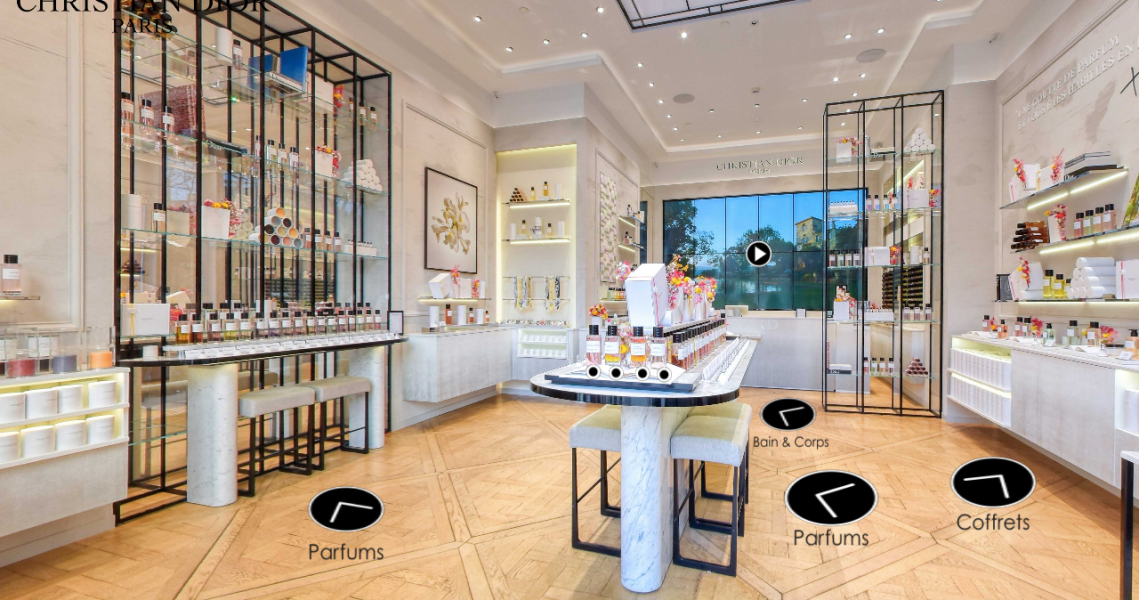Once an omnichannel experiment for a handful of innovation-focused brands, VR e-commerce is now seeing accelerated demand.
VR e-commerce technology is one of the many digital opportunities, like AI beauty tools and virtual consultations, that brands are seeking to offset losses from physical store closures. VR e-commerce startup Obsess, for example, has seen a 300% increase in inbound inquiries over the last four weeks, compared to the average monthly number from the beginning of 2019. The company recently worked with Dior to launch a virtual version of the luxury brand’s Champs-Élysées store in Paris in February. In China, Shanghai luxury art mall K11 launched a virtual store via a WeChat Mini Program that allowed users to tour the mall and purchase from 46 different brand stores.
Dior’s VR store offers shoppers of its French website a 360-degree, 3D e-commerce experience. Users can virtually browse the store’s Maison Christian Dior collection of fragrances, soaps, candles and lotions, and then zoom in on items and buy through the brand’s online shop. The brand has been expanding its e-commerce presence across geographies in recent years, selling a selection of fashion and beauty items.
Dior’s online store was developed with Obsess before the recent store closures. Ulta, Tommy Hilfiger, Farfetch and Levi’s are among others that have created their VR retail experiences with the company. Obsess founder and CEO Neha Singh said that Dior’s main motivation had originally been to share its Paris store with “a wide audience” that would not have have had the chance to see it in Paris.
“We are more targeting the younger generation,” said Singh, who noted that because younger people are larger consumers of esports and gaming, “they’re so used to this interface; they already understand how it works.” But she also noted that the look and feel of the experience needs to be more high-end than video games for beauty and luxury retailers. “For a brand, I don’t want it to look like a low-tech video game. The quality is so important; they need that for preserving their brand and their aesthetic,” said Singh.
And lately, they’re more willing to explore the technology. “We are now talking to almost every brand we had ever wanted to talk to, and they are reaching out to us,” said Singh. “Last month has been our busiest month.”
One main thing brands are losing as their stores are shut down is the effect of browsing.
Ad position: web_incontent_pos1
“Today’s e-commerce interface is great for directed shopping, which means you know what you’re looking for; you can search for it, but it’s not really the best experience for discovery,” said Singh.

Marie Driscoll, the managing director of luxury and fashion at Coresight, agreed. “The grid model is just so boring. People don’t just shop just because they need things. People shop to discover, learn and find out about new products.”
A selling point being made by VR tech companies is not just that the technology creates a more entertaining shopping experience for customers, but that it drives sales. According to Singh, the company’s VR stores have a 70% higher conversion rate than traditional grid e-commerce. However, the company did not have data on how many shoppers opt-in to the VR store experience.
Driscoll said beauty and luxury brands are among the segments best suited to this kind of technology. “Luxury has been slow to come on board with online, and many brands do not offer their full assortment, but if they can provide a wonderful experience online [including with other technologies like livestreaming and consultations with store associates], it’s going to be a game changer,” she said.
Ad position: web_incontent_pos2
Singh said Obsess shoots photos of physical stores for clients, but noted that brands have also shown interest in completely different virtual models that are not based on physical stores. Ulta adopted this format to display emerging brands via its Sparked program that launched last year.
This VR storefront already has presence in China: In 2018, Valentino launched a virtual store on Alibaba e-tailer Tmall allowing users to virtually tour the brand’s physical Beijing pop-up and purchase items on the shelves through Tmall. Amazon India has also experimented with this technology.
VR stores have a chance to become a more permanent feature if brands can see a return on investment from the technology. Singh said the technology is also being considered by brands for B2B purposes including wholesale showrooms and virtual conferences with livestreaming incorporated.
Driscoll predicted that when stores open again, the transition back to retail will be gradual due to fear of going to stores in public. Although physical retail will remain an important sales channel, she said that “the transition to online adoption is going to stick.”




